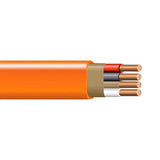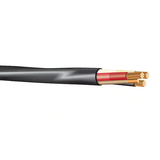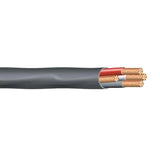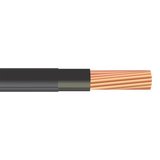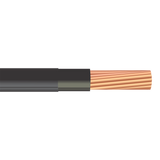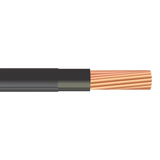Which Size Wire Is Used For Electric Dryers?
Installing or replacing an electric clothes dryer? Learn which wire size you should use. The article also covers the electric dryer circuit's ampacity, the difference between 3-Prong and 4-Prong outlets, and the types of cables recommended.

How Many Amps Does an Electric Dryer Take?
According to the National Electric Code, a dedicated circuit for an electric dryer should be 30 amps at minimum. A 30-amp dryer is typical for most homes. Also possible are 40-amp and 50-amp dryers. 40 Amp loads are common for dryers with a higher load and higher power requirements. A 50-amp dryer is the highest out of common power requirements. It is used in commercial and industrial settings.
Most electric dryers on the market are 220V/240V. 110/120 V circuits are rare and are associated with gas dryers.
It is important to install the breaker of the right ampacity with your electric dryer. If the circuit's ampacity is too low for your dryer, it will constantly trip, preventing you from using the dryer. If it is too high, there is a risk of an electric incident occurring.
Electric Dryer Wire Size
If you use copper wire, these are the wire sizes you need to choose for copper wire:
- For a 30-amp dryer, use 10 AWG copper wire
- For a 40-amp dryer, use 8 AWG copper wire
- For a 50-amp dryer, use 6 AWG copper wire
In cases where you use aluminum wire, the recommended sizing is:
- For a 30-amp dryer, use 8 AWG aluminum wire
- For a 40-amp dryer, use 6 AWG aluminum wire
- For a 50-amp dryer, use 4 AWG aluminum wire
3-Prong vs. 4-Prong Outlets For Electric Dryer
Electric dryers installed in houses before 1996 had a dedicated circuit with three conductors, including two live hot wires and one wire used as both ground and neutral. The cables had no dedicated ground slots, and the cables did not have a separate ground wire. They used a 3-prong outlet called a NEMA 10-30. The grounding in this type of outlet is exclusively achieved through a neutral wire.
In 1996, the National Electric Code introduced a requirement for 4-prong outlets (NEMA 14-30) with separate ground and neutral wires. While 3-prong outlets are safe enough to function, introducing 4-prong outlets means improved safety because it minimizes the risk of electrical shock to zero. All new dryers produced after 1996 require a 4-prong outlet and a cable with four conductors (2 live, a neutral, and a ground).
Should I Upgrade to a 4-Prong Outlet?
If you have a three-prong outlet and are installing a new dryer or replacing an existing one, it is generally recommended to upgrade to a four-prong outlet for improved safety and compliance with current electrical codes. This may involve rewiring the outlet and installing a new circuit. However, it is not necessary in all cases, and you can still use three-prong outlets with old installations and old dryers. Deciding whether to switch or not to switch to a 4-prong outlet requires consulting local electrical regulations.
What Kind of Wire Do You Use For a Dryer?
The most popular type of electric cables used for electric dryers is NM-B cable. There is no need to reinvent the wheel: NM-B is an easy-to-install interior cable ideal for dry places where electric dryers are installed.
NM-B Romex is not your only choice, though. When the outlet is mounted on a surface, such as a concrete or a block wall, the electrical circuit is typically installed using separate insulated wires (THHN/THWN) within nonmetallic or EMT conduit. The outlet itself can be a specialized surface-mount receptacle or a standard dryer receptacle installed within a surface-mounted box. The reason for using individual THHN/THWN wires in this case is that it is in accordance with NEC. Surface-mounted installations benefit from the additional protection that conduit provides.
Can You Use Aluminum Wire For The Electric Dryer?
Aluminum cables are safe for large electric circuits, such as dryer circuits, electric stoves, air conditioning units, and hot tubs. In these circuits, screw terminal connections are usually secure, which opens the room for aluminum cables. Therefore, you can easily use aluminum wire in 40-Amp and 50-Amp circuits. For 30-Amp circuits, the security of screw terminal connections is not that obvious, so copper is still the best choice.
Aluminum is a worse conductor compared to copper, but the reasons to choose it may include its lower weight and lower price. The wire run for dryers is usually short, so price is a small concern for electric dryer installations. With copper THHN/THWN and NM-B readily available, the only real reason to choose aluminum is if you got a good deal for it.
Which NM-B Wire to Use For Electric Dryers?
In the case of NM-B wire, when selecting cables for installation in 4-wire outlets, it is necessary to choose 10/3, 8/3, and 6/3 NM-B cables. This is because the grounding conductor is not included in the second number of the cable designation (e.g., 10/3). It's important to avoid mistakenly using cables like 10/4, 8/4, or 6/4, which indicate an additional conductor that is not required for a 4-wire installation. The most common NM-B cable choice for dryers is 10/3 for 30-amp circuits.
Types of Cables Not Recommended For a Dryer
It is not recommended to use extension cords or portable power cords like SOOW for electric dryers. These cables are not designed to sustain continuous electrical load and can easily overheat.



